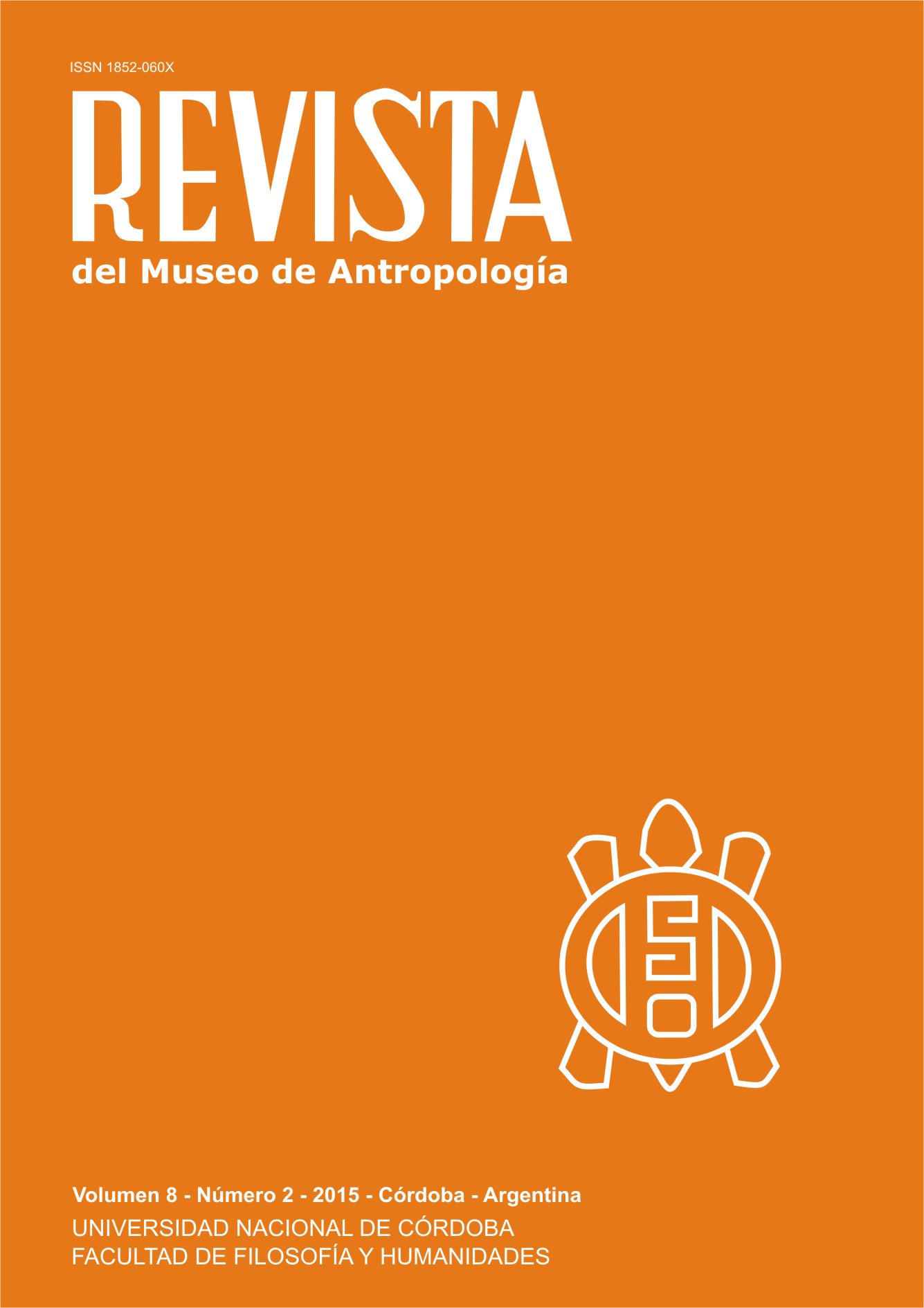The paradox of knowledge: little and good or a lot and regular?
DOI:
https://doi.org/10.31048/1852.4826.v8.n2.9461Keywords:
bioarchaeology, Calchaquí valley, museologic collection, archaeological rescues, Regional Development PeriodAbstract
The osteological collections deposited in museums, can provide important information with its degree of preservation, despite the lack of methodological rigor in their recovery. While the skeletal remains from systematic excavations and rescues are more complete but worse preserved. The aim of this work is to integrate information from bioarchaeological studies in samples from both sets, obtained from museum collections and those from systematic excavations and rescues. We take bioarchaeological analyzing samples to the site Fuerte Alto (Calchaqui Valley, Salta), from the Regional Development Period (PDR). It is about 16 skulls deposited in the Ethnographic Museum J.B Ambrosetti and 5 skeletons recovered in a rescue in 2006. We presented the results of the study of human skeletal remains, including composition and structure of the sample, deformatorias practices and evaluation of metabolic and mechanical stress.Downloads
References
Acuto, F. 2007. Fragmentación vs. integración comunal: Repensando el Período Tardío del Noroeste Argentino. Estudios Atacameños, 34: 71-95.
Ardissone, R. 1942. Un ejemplo de instalación humana en el valle Calchaquí. El pueblo de Cachi. Inst. Estudios Geográficos FFyL Monografías, 1. UNT.
Baffi, E. I. 1993. Caracterización biológica de la población prehispánica Tardía del sector septentrional del Valle Calchaquí, provincia de Salta. Tesis Doctoral. Facultad de Filosofía y Letras. Universidad de Buenos Aires. Inédita.
Baffi, E. I. 2011. La población prehispánica Tardía del sector septentrional del valle calchaquí) provincia de Salta, Republica Argentina). Anthropos, II Congreso Iberoamericano de Antropología. Memorias: 1138-1154. La Habana, Cuba.
Baffi, E. I., J. Cocilovo. 1990-91. La población tardía del sector septentrional del valle Calchaquí (Salta, Argentina). Runa, 19: 11- 26.
Bass, W. 1995. Human Osteology. Missouri Archaeological Society Special Publication. Fourth edition. Columbia, Missouri.
Bogin, B. 1999. Human Osteology. Missouri Archaeological Society Special Publication. Fourth edition. Columbia, Missouri. Cambridge Studies in Biological and Evolutionary Anthropology 23.
Brooks, S., J. Suchey. 1990. Skeletal age determination based on the os pubis: a comparison of the Acsadi – Nemeskeri and Suchey y Brooks method. Human Evolution, 3 (3): 227 – 238.
Buikstra, J., D. Ubelaker. 1994. Standars for Data Collection from Human Skeletal Remains. Arkansas Archaeological Survey Research Series, 44. Arkansas.
Cocilovo, J. A., E. I. Baffi. 1985. Contribución al conocimiento de las características biológicas de la población prehistórica de Puerta de La Paya (Salta). Runa, XV: 153-178. Buenos Aires.
Comas, J. 1966. Manual de antropología física, UNAM, México.
Debenedetti, S. 1908. Excursión arqueológica a las ruinas de Kipón. Publicaciones de la Sección Antropología, 4. Facultad de Filosofía y Letras, Buenos Aires.
Fazekas, G. y M. Kosa. 1978. Forensic Fetal Osteology. Akademiai Kiadó. Budapest
Huss – Ashmore, R, A. Goodman y G. Armelagos. 1982. Nutritional Inference from Paleopathology. Advances in Archaeological Method and Theory, 5: 395 – 473. Ed. M.Schiffer. Academic Press. New York.
Imbelloni, J. 1924-25. Deformaciones intencionales del cráneo en Sudamérica. Polígonos craneanos aberrantes. Revista Museo La Plata, XXVIII: 209-254. La Plata.
Krenzer, U. 2006. Compendio de métodos antropológico forenses para la reconstrucción del perfil osteo – biológico. CAFCA, Centro de Análisis Forense y Ciencias Aplicadas. Guatemala.
Larsen, C. 1997. Bioarcheology: Interpretating behavior from the human skeleton. Cambridge Studies in Biological Anthropology, 21. Cambridge University Press. Cambridge.
Lovell, N. 1997. Trauma Analysis in Paleopathology. Yearbook of Physical Anthropology, 40: 139-170.
Molnar, S. 1971. Human Tooth Wear, Tooth Function and Cultural Variability. American Journal of Physical Anthropology, 34: 175 – 189.
Rivolta, M. C., V. Seldes. 2010. El desarrollo del turismo arqueológico en Cachi (Salta, Argentina). Una experiencia de trabajo. En: Bienes Culturales, Turismo y Desarrollo Sostenible, edit. por J.M. Arévalo y R.E. Ledesma, pp. 283 - 298. Editorial Signatura. Sevilla, España.
Scheuer, L., S. Black. 2000. Development Juvenil Osteology. Academic Press. San Diego, California.
Seldes, V. 2007. Aportes de la bioarqueología al estudio de la complejidad y la desigualdad social en la Quebrada de Humahuaca (Jujuy, Argentina). Tesis Doctoral en Arqueología. Facultad de Filosofía y Letras, Universidad de Buenos Aires. Inédito
Seldes, V., M. F. Zigarán y J. Cabral. 2010. Restos óseos humanos recuperados en Fuerte Alto 1. XVII Congreso Nacional de Arqueología Argentina, tomo IV: 1545 – 1549.
Tarragó, M. N., P. P. Díaz. 1972. Sitios Arqueológicos del Valle Calchaquí. Estudios de Arqueología, 1: 49-61. Museo Arqueológico de Cachi, Salta
Waldrom, T. 2009. Palaeopathology. Cambridge Manuals in Archaeology.
Downloads
Published
Issue
Section
License
Those authors who have publications with this Journalaccept the following terms:
a. Authors will retain their copyrights and guarantee the journal the right of first publication of their work, which will be simultaneously subject to the Creative Commons Attribution License (Licencia de reconocimiento de Creative Commons) that allows third parties to share the work as long as its author and his first publication in this journal.
b. Authors may adopt other non-exclusive licensing agreements for the distribution of the version of the published work (eg, deposit it in an institutional electronic file or publish it in a monographic volume) provided that the initial publication in this journal is indicated.
c. Authors are allowed and recommended to disseminate their work on the Internet (eg in institutional telematic archives or on their website) before and during the submission process, which can lead to interesting exchanges and increase citations of the published work. (See The Effect of Open Access - El efecto del acceso abierto)












